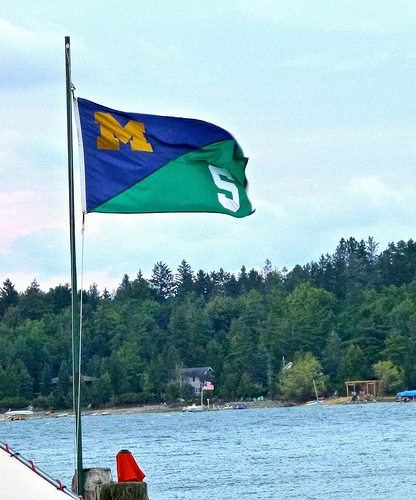Capital News Service

Seven out of 10 of the university products tested contained at least one hazardous chemical. Photo: Flickr/CC.
Michigan might be a divided house when it comes to college sports but the in-state rivalry might be more toxic than fans know.
Both University of Michigan and Michigan State University fan gear contained varying levels of potentially toxic chemicals, according to a recent study by the Ecology Center, an Ann Arbor-based nonprofit environmental organization.
The study examined 65 products for 19 universities bought from prominent retail stores around the country, environmental health campaign director Rebecca Meuninck said. Most University of Michigan products were purchased from a Walgreens in Ann Arbor and most Michigan State University products were purchased from a Kroger in East Lansing.
Other universities in the study included University of Wisconsin, University of North Carolina, Duke University and University of Connecticut. The study comes as a supplement to the HealthyStuff.org’s March Badness tournament to determine the most toxic university gear products.
HealthyStuff.org is a project of the Ecology Center.
The products were examined for lead, chlorine, cadmium, arsenic, mercury, bromine and tin which can cause health concerns including children’s developmental issues, reproductive problems and types of cancer.
Researchers found seven in 10 university products contained one or more hazardous chemicals, according to HealthyStuff.org. The products often exceeded U.S. Consumer Products Safety Commission standards for lead and phthalates in children’s products.
Items included University of Michigan shoes for toddlers determined to have high amounts of chlorine and a University of Michigan jersey with high levels of bromine and lead in the ink print, both purchased from Target. A Michigan State University seat cushion containing high levels of cadmium and lead was purchased at Kroger.
Items with low toxicity included a Michigan State University rain poncho and car flag purchased at Kroger and a University of Michigan car flag purchased at Walgreens.
A Michigan State University keychain and lanyard and a University of Michigan lanyard purchased at Home Depot were determined to have medium levels of toxic chemicals, according to the study.
“We haven’t seen the full report, but I can assure that we’re committed to working with our suppliers and manufacturers to ensure products are safe and comply with applicable regulations,” Catherine Woodling, Home Depot corporate communications manager, wrote in an email statement.
Although chemical levels differed across products, several had high levels of chemicals associated with color on the item.
The tools used for research in this study are used for screenings and cannot provide the scientific analysis of other tools, said Alex Filip, deputy director of communication for the U.S. Consumer Product Safety Commission.
The presence of the contaminants does not necessarily mean that people are exposed to them.
That would require additional testing, Filip said.
In recent years, major retailers including Target and Walmart have released new policies to encourage manufacturers to use safer chemicals in their products.
“There’s no reason why major retailers, such as Walgreens, should be selling these materials,” said Mike Schade, a campaign director for Safer Chemicals, Healthy Families, a national coalition of public health organizations, health advocates and businesses.
The study found 20 products were made with low amounts of potential toxic materials.
“Clearly with March Madness many students, parents and even children are buying these products this time of year,” Schade said. “This study shows that people should really take caution this time of year.”
Researchers selected items they thought were likely to be purchased by fans and focused on items children might play with or come into contact with, Meuninck said.
Children are the most vulnerable to hazardous chemicals, but adults might want to be careful of what they purchase as well.
“Many folks would like to choose safer products when (they’re) able to,” Meuninck said. “It’s something to keep an eye on.”
The degree of danger to adults and children might depend on the specific types of chemicals found in the products, as there are different types of chemicals such as mercury, said Angela Minicuci, Michigan Department of Community Health public information officer.
“When we see poisoning related to mercury or lead, it’s actually things in the home – lead paint or toxins in the air,” Minicuci said. “We see things more with the environment than we do with products such as these.”
Check out this list of Michigan State University and University of Michigan fan gear and the highest noted chemical in the product, according to a recent study by the Ecology Center:
